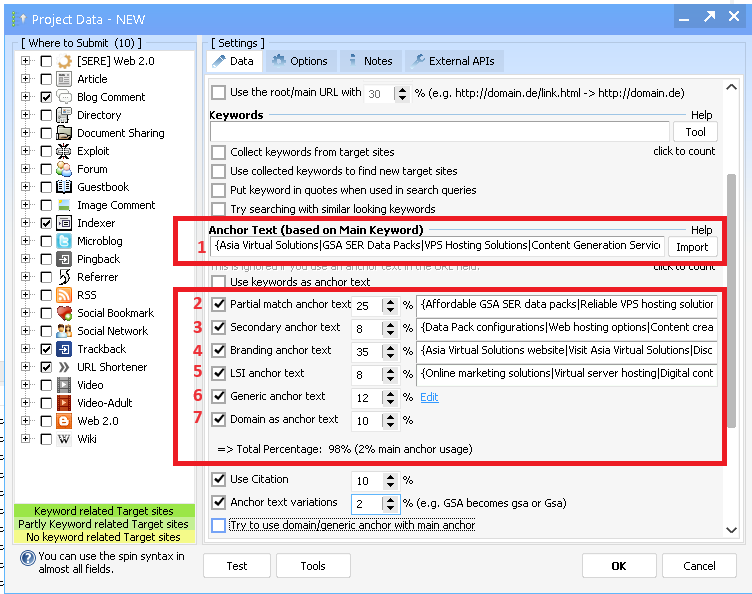If you're diving into the vast ocean of SEO with the GSA Search Engine Ranker at your side, you've probably realized how crucial the proper anchor text variations can be for your link-building journey. It's like crafting the perfect spice blend for your favorite dish—get it right, and you'll savor the sweet taste of SEO success.
That's why today, we're looking at the anchor text variation options in GSA Search Engine Ranker and showing you exactly how to set your anchor text variations for maximum impact. If you don't like reading so much, then you will find the walk thru video a little further down, which shows you the settings in GSA SER
Whats the big deal with Anchor Text Variations
You might wonder what the big deal is with anchor text variations and why you bother using them. Why not use the default anchor text option in GSA Search Engine Ranker and not be bothered with the rest?
Well, my friend, sorry to burst your bubble, but anchor text variation is a big deal. With all the algorithms updated from Google, it is time you start taking anchor text variations a bit more seriously.
Here is 6 points why anchor text variations is important.
- Avoids Penalties: Search engines, especially Google, have become adept at identifying over-optimization. Using the same anchor text repeatedly can trigger penalties or negative adjustments in your search rankings. Variations help you appear more natural and avoid these penalties.
Enhances Relevance: By using a range of related keywords and phrases as anchor texts, you signal to search engines the breadth and depth of your content's relevance to various queries. This can help improve your rankings for a wider array of search terms.
Improves User Experience: Diverse anchor texts can make links more informative and contextually relevant for users, enhancing their browsing experience. This can lead to better engagement, lower bounce rates, and higher conversion rates.
Strengthens Link Profile: A varied link profile is seen as more natural and trustworthy by search engines. It indicates that links to your site come from a genuine interest in your content rather than artificial link-building schemes.
Targets a Broader Set of Keywords: Variations allow you to rank not just for your primary keywords but also for secondary and long-tail keywords, which can be less competitive and more targeted towards specific queries.
Aids in Ranking for Semantic Searches: With the evolution of search algorithms towards understanding searcher intent, using synonyms and related terms (LSI keywords) as anchor texts helps you rank better in semantic searches.
Anchor text variations are very important for a good SEO plan. They help make sure your link-building work is successful and follows the best rules. This helps your website grow naturally and get better positions in search engine results, so be sure to set them in GSA Search Engine Ranker, as we will exlain in the next section.
What are the recomended anchor text variation settings you should be using in GSA SER
Creating a balanced and effective link building strategy is essential for SEO, and using anchor text variations when building GSA projects, can play a significant role in this. The exact percentages can vary based on the nature of your website, the competition in your niche, and changes in search engine algorithms, but I can give you a starting point based on general best practices.
Anchor text variation based on best practises
- Main Anchor Text: 1-2%
- Partial Match Anchor Text: 20-30%
- Secondary Anchor Text: 5-10%
- Branding Anchor Text: 30-40%
- LSI Anchor Text: 5-10%
- Generic Anchor Text: 10-15%
- Domain as Anchor Text: 10-15%
Anchor Text Variations used by Asia Virtual Solutions
- Main Anchor Text: 2%
- Partial Match Anchor Text: 25%
- Secondary Anchor Text: 8%
- Branding Anchor Text: 38%
- LSI Anchor Text: 8%
- Generic Anchor Text: 12%
- Domain as Anchor Text: 10%
These percentages are not set in stone. It's important to monitor your SEO performance and adjust your strategy accordingly. Also, focus on getting links from high-quality, relevant sources, as the quality of links is generally more important than the exact anchor text types. Keeping an eye on updates from Google and SEO research can help you adjust these percentages over time to be in line with the ever evolving best practices.
How To Justify the Recomended Anchor Text Variations
I promise you I did not just suck these numbers out of the air, nor did I just guess a number for the above recomendations.
The recommended percentages for each type of anchor text in a link-building strategy are based on general SEO best practices and the goal of maintaining a natural and balanced profile that aligns with Google's guidelines.
Below is the Rationale For Each Recommendation:
Main Anchor Text (Exact Match) - 2%
Main Anchor Text Reasoning:
This should be used sparingly, as over-optimizing exact match anchor text can lead to Google penalties. Aim for around 1-2%. It's crucial to ensure these links come from high-quality, relevant sources.
Using the exact match anchor text directly corresponds to the keyword(s) you wish to rank for. While powerful if used correctly, Google has increasingly penalized overuse as it often points to attempts to manipulate rankings.
Reference:
Google's Webmaster Guidelines explicitly caution against “link schemes” that attempt to manipulate a site's ranking. More details can be found in Google's Webmaster Guidelines.
Partial Match Anchor Text - 25%
Partial Anchor Text Reasoning:
Slightly broader than exact match, this includes variations of your primary (main ) keyword. It's less risky and should constitute 20-30% of your profile. This allows for relevance without the risk of appearing manipulative.
This strategy involves anchors that contain a variation of the target keyword, offering a safer, more diversified approach than exact matches. It helps in maintaining relevance without triggering over-optimization flags.
Reference:
Moz's guide on anchor text strategies highlights the importance of variation and context, underscoring the role of partial matches. Further insights can be explored in Moz's Anchor Text Guide.
Secondary Anchor Text - 8%
Secondary Anchor Text Reasoning:
These are related keywords that aren't your main target but are still relevant to your content. Around 5-10% is a good range. This helps rank long-tail keywords and improves overall site relevance.
Secondary or related keywords that aren't the main focus but are still relevant to your content can help you rank for a broader range of search terms, improving your site's visibility and traffic.
Reference:
The concept of secondary anchor texts aligns with targeting a broader keyword set, as discussed in Search Engine Journal's comprehensive SEO guides. A detailed exploration can be found at Search Engine Journal.
Branding Anchor Text - 35%
Branding Anchor Text Reasoning:
Using your brand name as anchor text is safe and recommended. This should comprise a significant portion of your profile, around 30-40%. It helps build brand recognition and is seen as natural by search engines.
Anchors using your brand name are seen as trustworthy and natural. They're less susceptible to penalties and help build brand awareness and authority, which are increasingly important in Google's evaluations.
Reference:
Insights from Google's John Mueller in various webmaster hangouts emphasize the value of branding in SEO. Further reading on brand building and SEO can be found on Search Engine Watch.
LSI Anchor Text - 8%
LSI Anchor Text Reasoning:
These are synonyms or variations related to your main keywords. They can account for 5-10% of your profile. LSI anchors help search engines understand your content's context and relevance to various queries.
LSI (Latent Semantic Indexing) keywords are synonyms or related terms to your main keywords. Using LSI anchors helps search engines better understand your content's context, aiding in semantic search.
Reference:
Several authoritative sources discuss the impact of LSI on SEO, including Backlinko's SEO guide, which explains how semantic relevance can influence search rankings.
Generic Anchor Text - 12%
Generic Anchor Text Reasoning:
These are non-descriptive phrases like “click here” or “read more.” Although not particularly valuable for keyword rankings, they can add naturalness to your link profile. Use them sparingly, around 10-15%.
Generic anchor texts like “click here” or “learn more” are user-friendly and contribute to a natural link profile. They improve the usability of your content and can indirectly benefit SEO by enhancing user engagement.
Reference:
Neil Patel discusses the importance of user experience in SEO and how generic anchor texts fit into this at Neil Patel's Blog.
Domain as Anchor Text - 10%
Domain Anchor Text Reasoning:
Including naked URLs as anchor text is another strategy to diversify and add naturalness to your link profile. This should also be around 10-15% of your links.
Using your website's URL as anchor text is another way to maintain a natural link profile. It's straightforward and unlikely to be viewed suspiciously by search engines while promoting brand recognition.
Reference:
Practical Ecommerce provides insights into creating a natural backlink profile, including using naked URLs, at Practical Ecommerce.
Where to Enter the Anchor Text Variations in GSA Search Engine Ranker
In GSA Search Engine ranker you will find the anchor text options on the front screen, known as the Data tab screen, when you start a new project.
Below are the different fields in GSA SER
This is your Main Anchor Text (Exact Match), here yoou are not able to set a percentage, as it will automatically based on whats left of 100% after you added the ones in no. 2 – 7. Normally we will aim for 1 – 2% here.
- Partial Match Anchor text you should use 10 – 20%.
- Secondary Anchor text we want to be using 5 – 10%.
- Branding anchor text we want to use around 30 – 40%.
- LSI Anchor text(Latent Semantic Indexing) we need to aim for 5 – 10% usuage.
- Generic Anchor text we want to be using around 10 -15%.
- Domain as Anchor Text you need to use around 10 -15%

How to Add Anchor Text Variations In GSA SER
AI Anchor Text Variation Tool
- Not everyone is sure how to create the anchor text variations needed for GSA Search Engine ranker and other tools. So to help you i have create a Open AI GPT that will generate the anchor text for you.
The free anchor text tool will create for you all the required anchor text, based on your website URL or 3 keywords that you enter.
How to use the AI Anchor Text Generator
- Click the button below to go to theOpenAI GPT from Asia Virtual Solutions, or just follow this link – https://asiavirtualsolutions.com/anchortexttool (Please note you will need a Vhat GPT PLUS subscription to use GPT's.
- Once you are on the GPT screen you will have 4 options how to proceed, as below (select only one of the below options):
- Add your website link and enter. e.g https://asiavirtualsolutions.com
- Add the 3 main keywords you want to promote (can be coma seperated or one below each other: keyword1, keyword2, keyword3, and hit enter.
- Add website link and language you require -e.g = https://example.com, Language: French , and hit enter
- Add 3 anchor text and language you require – e.g = keyword1, keyword2, keyword3, Language: Spanish , and hit enter.
- Once you have entered the information and hit enter, then just wait a few secons for the output.
- You will now see the anchor text variations and the recomended percentage to use for each.
- To use the Anchor text variations in GSA Search Engine Ranker you can use this online Spin Syntax tool to convert the anchor text in to Spyn syntax so you can easily add it to GSA Search Engine Ranker – https://spintaxgenerator.com
Statistics on Anchor Text Variations
- According to a study conducted by Ahrefs, over 30% of referring pages contain bracketed anchor text, showing the prevalence of exact match anchor text variations in content.
- A SEMrush study indicates that search results rankings have a correlation with anchor text variations. The top-ranked websites often employ balanced and diverse anchor text strategies.
- In an analysis conducted by Moz, branded anchor texts dominate over 70% of the link profile for top websites, emphasizing the importance of branded anchor text.
- Research by LinkAssistant shows that only about 10% of websites make effective use of partial match anchor text variations, suggesting a potential area of improvement for many sites.
- An observation by Ahrefs indicates that generic anchor texts like ‘here', ‘website' or ‘click here', although not directly important for keyword ranking, still constitute about 20% of overall anchor texts, emphasizing their role in a natural-looking link profile.
External References We Used to Compile This Post
- Ahrefs' Guide on Anchor Text: This comprehensive guide covers everything you need to know about anchor text, including its relevance in SEO and the importance of anchor text variations.
- Moz's Learning Center on Anchor Text: A useful resource for understanding anchor text, its different types, and the role of anchor text variations in link building.
- Backlinko's Hub on Anchor Text: This is an in-depth article explaining different types of anchor text variations and their impact on SEO rankings.
- Search Engine Journal's Guide on Anchor Text: This piece delves into the concept of anchor text, diversity, and relevance in achieving SEO goals.
- SEMRush's Guide on Anchor Text Optimization: This guide provides tips and techniques on how to diversify and optimize your anchor text effectively for SEO.
- Spintax Generator is a very handy tool we used to convert the results from the Anchor Text tool to Spin Syntax so we could easily add it to GSA Search Engine ranker
Frequently Asked Questions About Anchor Text Variations
Here Are Pointers on How to Do Anchor Text Variations
How to Strategically Implement Anchor Text Variations for SEO?
To strategically use anchor text variations for SEO, start by identifying a mix of target keywords including both short-tail and long-tail keywords. Create a list of potential anchor texts using exact match keywords, partial match keywords, branded phrases, and generic phrases. Make sure to avoid over-optimizing any specific type of anchor text. Implement these variations in your content in a natural and organic way.
How to Use Branded Anchor Text Variations?
To use branded anchor text variations, include your brand name within the hyperlinks that link back to your site. This has the dual benefit of promoting your brand while also contributing to a balanced backlink profile. Remember to make sure the brand name fits naturally within the content to maintain good readability for the users.
How to Create Effective Partial Match Anchor Text Variations?
Creating effective partial match anchor text variations involves including a subset of your target keywords within your anchor text. The anchor text should give the reader a good idea of what to expect on the linked page. When creating a partial match variation, make sure the keyword fits naturally within a wider phrase, so the link doesn’t appear forced.
How to Diversify Your Anchor Text Profile?
Diversifying your anchor text profile involves using a good mix of anchor text variations that include exact match, partial match, branded, generic, and naked URLs. In addition, consider diversifying the pages you link to. Don’t always link to your homepage. Rather, provide valuable resources on other pages within your site. The key is to use anchor text variations in a natural and balanced way.
How to Measure the Effectiveness of Anchor Text Variations?
Measuring the effectiveness of anchor text variations mainly involves tracking your website's ranking for your target keywords. Tools like Google Analytics and Google Search Console can provide valuable data for this purpose. Another important metric is traffic—particularly organic traffic—since effective anchor text strategies should result in improved visibility and increased visitors to your website. Make sure to regularly assess and adjust your anchor text strategies based on the resulting data.
















